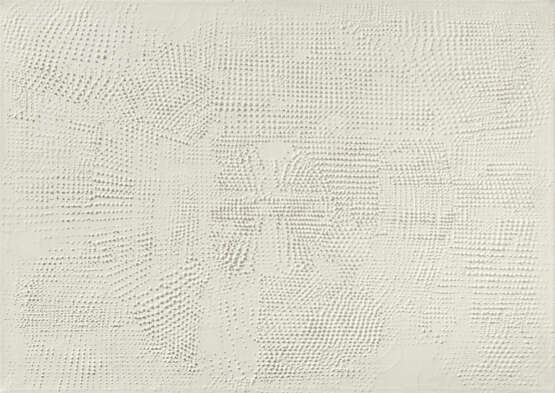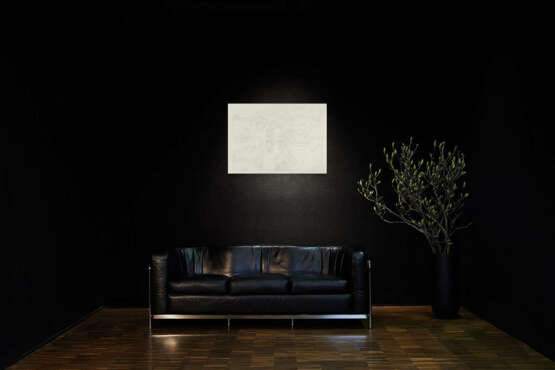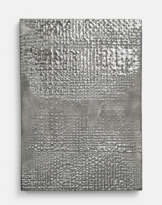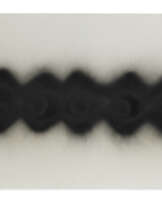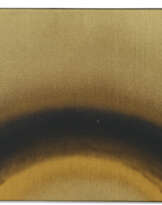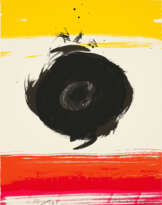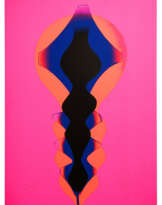ID 1405992
Lot 152 | Otto Piene. Gelbhellhell
Estimate value
€ 150 000 – 250 000
1928 Laasphe/Westphalia - 2014 Berlin
Title: Gelbhellhell.
Date: 1959/60.
Technique: Oil on untreated cotton.
Measurement: 67 x 96cm.
Notation: Signed and dated verso upper right: Piene (circled) 59/60.
Frame/Pedestal: Craftman's frame.
Provenance:
- Galerie Schmela, Düsseldorf
- Bayer AG, Leverkusen (acquired from the previous owner in 1960)
Exhibitions:
- Deutscher Künstlerbund, Essen 1958 (label)
- Martin-Gropius-Bau, Berlin 2013
Literature:
- Exhib. cat. From Beckmann to Warhol, Art of the 20th and 21st Centuries - The Bayer Collection, Martin-Gropius-Bau, Cologne 2013, p. 211, fig.
- Key work from the early phase of ZERO of museum quality
- Outstanding example of the group of grid paintings
- Rare early work by the main representative of the ZERO group
Otto Piene - Maler des Lichts
Das Bild "Gelbhellhell" steht exemplarisch für Otto Pienes Vorstellung eines neuen Anfangs in der Kunst. Für Piene war das Licht zum zentralen Thema dieses Neuanfangs geworden - das Licht stand für Helligkeit, es war weiß oder weißgelb. Im Sommer 1957 hatte Piene seine ersten Rasterbilder (er selbst nannte sie "Raster-Licht-Bilder") gemalt, mit denen er eine optimistischere Antwort auf die in seinen Augen morbide, dunkle Ästhetik des damals vorherrschenden Informel gab. Indem er die Farbe durch ein Rastersieb auf den Bildträger auftrug - er drückte die pastose Ölfarbe durch das Sieb auf die Leinwand, so dass sich eine Struktur aus plastischen Erhebungen der Farbe ergab, die keine individuelle, gestische Setzung wie in der informellen Malerei mehr war, sondern eine objektiv erscheinende, monochrome und systematisch organisierte Fläche, gelang ihm eine Distanzierung von der vorherrschenden informellen Malerei. Zur 8. Abendausstellung in Pienes Atelier zum Thema "Vibration" im Oktober 1958 schrieb Otto Piene sein Manifest "Über die Reinheit der Farbe", in dem es heißt: "Das Licht ist die erste Bedingung aller Sichtbarkeit. Das Licht ist die Sphäre der Farbe. Das Licht ist das Lebenselement des Menschen und des Bildes. Jede Farbe gewinnt ihre Qualität durch den Anteil an Licht, der ihr beschieden ist. Das Licht macht die Kraft und den Zauber des Bildes, seinen Reichtum, seine Beredtheit, seine Sinnlichkeit, seine Schönheit aus." (Otto Piene in: ZERO 2, Düsseldorf 1958, S. 24) Seine Abgrenzung zum Informel reflektierte er dort wie folgt: "In der Revolution gegen die Revolution entstanden das action painting Pollocks und die offensichtliche Mystik der Bilder von Wols. Die daran inspirierte Bewegung des Informel hat der Malerei den élan vital wiedergegeben. Der Preis für diesen Gewinn war außerordentlich hoch: es war der Verzicht auf die Reinheit der Farbe (.). Die Farbe konnte nicht rein werden, weil man sich der dazu unerlässlichen Bedingung begeben hatte." (Ebd.) Genau diese Freisetzung der reinen Farbe leisten Pienes Rasterbilder, für die "Gelbhellhell" ein hervorragendes Beispiel ist.
Im Kontext von ZERO
Otto Pienes Raster-Licht-Bilder versinnbildlichen seine fundamentale Auseinandersetzung mit dem Kontrast von Licht und Dunkel - ihnen gegenüber stehen seine Rauchzeichnungen und Feuerbilder, in denen der fortwährende Kampf zwischen Hell und Dunkel von der anderen Seite ausgetragen wird. Zusammen mit Bildern wie "Kreisweiß", 1957 (Leopold-Hoesch-Museum Düren), "La force pure I", 1958 (Museum of Modern Art, New York) oder "Ein Fest für das Licht", 1958 (Kunstpalast, Düsseldorf) demonstriert "Gelbhellhell" Pienes wesentlichen Beitrag zum Programm der Gruppe ZERO. Das Licht seiner Rasterbilder erzeugt eine "optische Vibration", die "mit einem Energiefeld vergleichbar" ist, dessen Wirkung metaphysische Qualität hat. (Vgl. Kemp, Willi: Dialog mit der Kunst, Düsseldorf 2018, Bd. II, S. 637) Die meisten Bilder dieser Werkgruppe befinden sich heute in öffentlichen Sammlungen, mit Gelbhellhell kommt ein selten verfügbares Werk von musealer Qualität auf den Markt. Gelb blieb für Otto Piene zeitlebens die wichtigste Farbe, und nur einer seiner engsten Freunde war in der Lage, vom Künstler eines seiner späten Lieblingsbilder erwerben zu können, das den bezeichnenden Titel "Gelb, teurer Freund" trägt.
Das Bild wurde von der Galerie Schmela erworben. Alfred Schmela war während der späten 1950er-Jahre bis 1980 einer der wichtigsten Galeristen in Düsseldorf. Otto Piene hatte bei ihm seine erste Einzelausstellung, und er blieb Schmela bis zu dessen Tod 1980 eng verbunden.
Kay Heymer.
| Artist: | Otto Piene (1928 - 2014) |
|---|---|
| Applied technique: | Oil |
| Auction house category: | Post War paintings, drawings, watercolours |
| Artist: | Otto Piene (1928 - 2014) |
|---|---|
| Applied technique: | Oil |
| Auction house category: | Post War paintings, drawings, watercolours |
| Address of auction |
VAN HAM Kunstauktionen GmbH Hitzelerstr. 2 50968 Köln Germany | ||||||||||||||
|---|---|---|---|---|---|---|---|---|---|---|---|---|---|---|---|
| Preview | |||||||||||||||
| Phone | +49 221 92586215 | ||||||||||||||
| Fax | +49 221 92 58 62 4 | ||||||||||||||
| Buyer Premium | 32% | ||||||||||||||
| Conditions of purchase | Conditions of purchase | ||||||||||||||
| Business hours | Business hours
|
